Figures & data
Figure 1. Deletion of CD39 in SK-MEL-28 cells is accompanied by near-complete loss of NTP/ADPase but not AMPase activities. A, The initial velocities of wildtype SK-MEL-28 CD39-mediated Pi release were plotted against a titration of substrate concentrations and fit to the Michaelis-Menten model. Error bars, S.D., n= 2. B, A CD39 KO derivative of the SK-MEL-28 cell line (SK-MEL-28-KO-W3) showed a near-complete reduction of Pi release for all substrates other than AMP, confirming the deletion of CD39. AMP hydrolysis is mediated by CD73. Error bars, S.D., n= 2. C, Confocal microscopy analysis of CD73, CD39, and TNAP expression in wildtype SK-MEL-28 and SK-MEL-28-KO-W3 cells. Scale bars, 40 µm
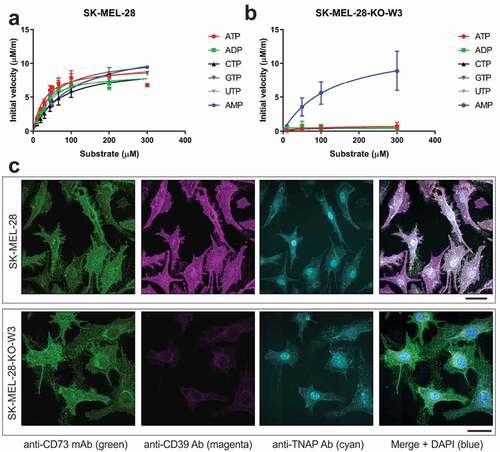
Figure 2. Anti-CD39 mAb, TTX-030, binds to CD39 with high affinity and specificity. A, TTX-030 Fab binds to a distinct epitope from anti-CD39 clone A1 mAb as measured by biolayer interferometry (BLI). Left panel, A1 mAb was captured to anti-murine IgG Fc biosensors and saturated with rhCD39-ECD. The competition association step sensorgram is shown with TTX-030 Fab, but not A1 or isotype control, producing a BLI binding response. Right panel, TTX-030 Fab was captured to anti-human Fab-CH1 biosensors and saturated with rhCD39-ECD. The competition association step sensorgram is shown with A1, but not TTX-030 Fab or isotype control, producing a BLI binding response. B, By cellular ELISA, TTX-030 had a subnanomolar EC50 for CHO cells overexpressing human CD39 but did not bind CHO cells overexpressing other extracellular human NTPDases. By flow cytometry, TTX-030 had a subnanomolar EC50 for SK-MEL-28 and primary human B cells. Error bars, S.D.; n= 3. MFI, mean fluorescence intensity.
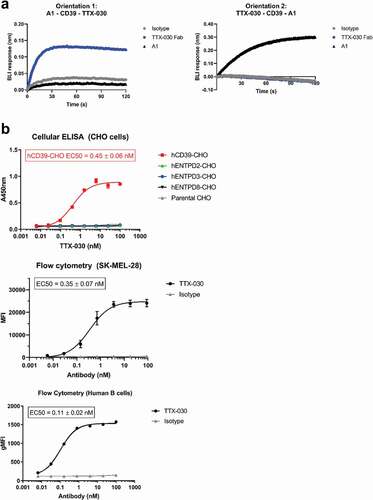
Figure 3. TTX-030 inhibits soluble and cell-surface expressed CD39-mediated NTP and ADP hydrolysis. A, A titration of TTX-030 or isotype control (hIgG4) was pre-incubated with rhCD39-ECD for 1 h prior to the addition of ATP substrate. The amount of free Pi was quantified after a 30 min incubation with ATP. TTX-030 inhibited rhCD39-ECD ATPase activity with an IC50 of 0.20 ± 0.06 nM with 55% maximal inhibition. Nonselective inhibitor POM-1 at 150 µM inhibited rhCD39-ECD activity by approximately 80%. Error bars, S.D.; n= 2. B, The assay in A using rhCD39-ECD was repeated with other NTP substrates. TTX-030 has similar potency (IC50) and maximal inhibition of CD39 NTPase activity. Error bars, S.D.; n= 2. C, TTX-030 maximally inhibits SK-MEL-28 cellular CD39 NTPase and ADPase activity to a greater extent than rhCD39-ECD. Maximal percent inhibitions are reported here without correcting for residual non-CD39-mediated NTP/NDPase activity. D, TTX-030 inhibits CD39-mediated Pi release of primary human B cells. E, TTX-030 and POM-1 inhibit tonsillar CD39-mediated ADPase activity in situ. Enzyme histochemistry images were captured using slide scanner. Nearly complete inhibition of brown staining in the presence of TTX-030 precludes proper comparative quantification of staining intensities in control versus treated sections. Scale bars, 3 mm
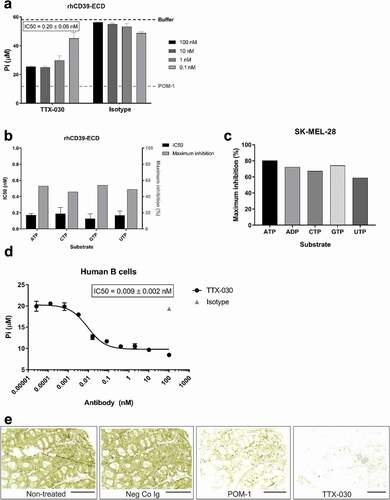
Figure 4. TTX-030 is an uncompetitive inhibitor of CD39 ATPase activity. A, SK-MEL-28 CD39-mediated ATPase initial velocities of Pi release as a function of ATP concentration were plotted for a titration of TTX-030 IgG (left panel) or Fab (right panel) and globally fit to the partial, mixed inhibition equation to obtain the inhibitor constant, Ki, α, and β. α is a parameter that determines the mechanism of inhibition where α < 1 indicates an uncompetitive mechanism; β is a parameter that determines the extend of partial inhibition where zero indicates complete inhibition and 1.0 indicates no inhibition. IgG, Error bars, S.D., n= 4. Fab, Error bars, S.E., n= 1. B, Binding kinetics of a highly related precursor to TTX-030 to recombinant extracellular domain of human CD39, rhCD39-ECD, in the presence or absence of non-hydrolyzable ATP analog, AMP-PNP. Binding to rhCD39-ECD was approximately 2-fold stronger in the presence of 1 mM AMP-PNP, supporting an uncompetitive mechanism. Data were globally fit to 1:1 binding model. KD, dissociation constant; kon, association (or on) rate; koff, dissociation (or off) rate
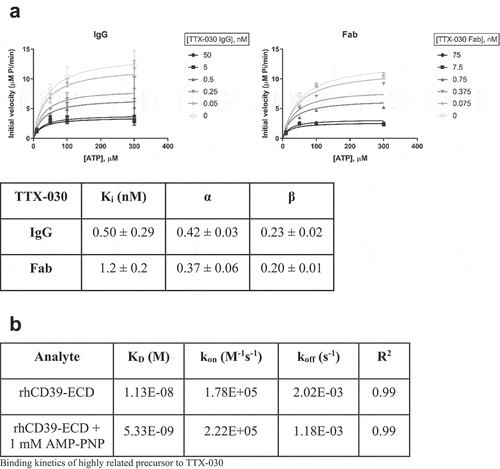
Figure 5. Effect of TTX-030 and POM-1 on the pattern of3HATP metabolism by SK-MEL-28 cells. A, Radio-TLC assays tracked the inhibition of CD39-mediated hydrolysis of3H-labeled ATP of SK-MEL-28 cells by POM-1 (10 µM) and a suboptimal treatment of TTX-030 (200 ng/ml). The kinetic parameters (Vmax and Km) for all catalytic activities were calculated from the presented curves and summarized in the right panel. Error bars, S.E., n= 3. *P < .05 as compared with control. B, Cultured SK-MEL-28 cells were incubated with 100 μM3HATP and subsamples of the medium were collected at timed intervals, followed by TLC separation and quantification of the amount of3HATP and its dephosphorylated3H-metabolites, ADP, AMP and adenosine (ADO). The ordinate shows the relative content of3H-labeled nucleotides and ADO expressed as percentage of total radioactivity added. Error bars, S.E., n= 2. Lower panel depicts a representative autoradiographic image of an overall pattern of metabolism of3HATP by control and treated cells. The blank (Bl) shows the radiochemical purity of3HATP in the absence of cells. Arrows indicate the positions of nucleotide and ADO standards
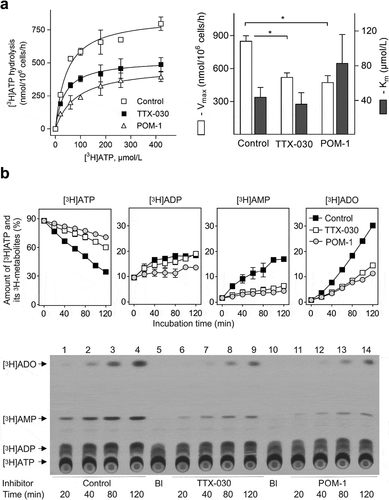
Table 1. Allosteric mechanism of inhibition confirmed via mapping epitope to a region of CD39 distal to active site
Figure 6. TTX-030 robustly inhibits CD39 under stressed and/or TME-like conditions. A, Washing unbound TTX-030 prior to adding ATP and extending the TTX-030 pre-incubation step from 1 h to 25 h had no effect on maximal inhibition, (1-β). However, the potency (Ki and IC50) was reduced, especially for TTX-030 Fab. SK-MEL-28 CD39-mediated ATPase initial velocities of Pi release as a function of ATP concentration were determined for a titration of TTX-030 (full length and Fab) and globally fit to the partial, mixed inhibition equation to obtain inhibitor constant, Ki, α, and β. α is a parameter that determines the mechanism of inhibition where α < 1 indicates an uncompetitive mechanism; β is a parameter that determines the extend of partial inhibition where zero indicates complete inhibition and 1.0 indicates no inhibition. Error, S.E., n= 1. IC50 was calculated from plotting initial velocities as a function of TTX-030 concentration for each ATP concentration and fitting to a three-parameter nonlinear regression model. Error, S.D., n= 3–4 across [ATP]. B, TTX-030 continued to inhibit cellular CD39 ATPase activity despite a continuous replenishment of an ATP reservoir. A dose titration of ATP was added to the reaction every 3 min and then the Pi release was determined over time. SK-MEL-28 CD39-mediated ATPase initial velocities as a function of ATP concentration were plotted for a titration of TTX-030. Only the first dose of ATP is shown for buffer only and isotype controls because the release of Pi was no longer at steady state at subsequent doses. Error bars, S.E., n= 1. C, TTX-030 (10 nM) maintained equal maximal inhibition of SK-MEL-28 CD39-mediated ATPase activity at pH 7.5 and TME-like pH 6.5. The Pi release velocity in the absence of TTX-030 was reduced at lower pH. Error bars, S.E., n= 1
![Figure 6. TTX-030 robustly inhibits CD39 under stressed and/or TME-like conditions. A, Washing unbound TTX-030 prior to adding ATP and extending the TTX-030 pre-incubation step from 1 h to 25 h had no effect on maximal inhibition, (1-β). However, the potency (Ki and IC50) was reduced, especially for TTX-030 Fab. SK-MEL-28 CD39-mediated ATPase initial velocities of Pi release as a function of ATP concentration were determined for a titration of TTX-030 (full length and Fab) and globally fit to the partial, mixed inhibition equation to obtain inhibitor constant, Ki, α, and β. α is a parameter that determines the mechanism of inhibition where α < 1 indicates an uncompetitive mechanism; β is a parameter that determines the extend of partial inhibition where zero indicates complete inhibition and 1.0 indicates no inhibition. Error, S.E., n= 1. IC50 was calculated from plotting initial velocities as a function of TTX-030 concentration for each ATP concentration and fitting to a three-parameter nonlinear regression model. Error, S.D., n= 3–4 across [ATP]. B, TTX-030 continued to inhibit cellular CD39 ATPase activity despite a continuous replenishment of an ATP reservoir. A dose titration of ATP was added to the reaction every 3 min and then the Pi release was determined over time. SK-MEL-28 CD39-mediated ATPase initial velocities as a function of ATP concentration were plotted for a titration of TTX-030. Only the first dose of ATP is shown for buffer only and isotype controls because the release of Pi was no longer at steady state at subsequent doses. Error bars, S.E., n= 1. C, TTX-030 (10 nM) maintained equal maximal inhibition of SK-MEL-28 CD39-mediated ATPase activity at pH 7.5 and TME-like pH 6.5. The Pi release velocity in the absence of TTX-030 was reduced at lower pH. Error bars, S.E., n= 1](/cms/asset/dcd5796d-864d-4fb7-a310-393b91c70162/kmab_a_1838036_f0006_oc.jpg)
